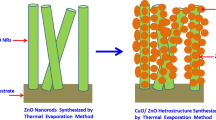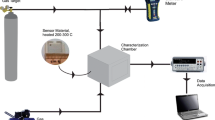Abstract
V2O5 nanostructures were successfully deposited on glass substrates by hydrothermal method at 180 °C for the deposition times of 4, 6, 8, 10 h. The effect of deposition time on the structural, morphological, compositional and H2S gas sensing properties of the nanostructures were investigated by XRD, SEM, EDAX and gas measurement system, respectively. The XRD and SEM studies indicated that the nanostructures had polycrystalline nature with monoclinic phase of V2O5 and the structural and morphological properties of the nanostructures depended on the deposition time. The sensing measurements of the sensors were made based on temperature and gas concentration. The sensors exhibited high responses towards 50 ppm H2S gas concentration at operating temperature of 145 °C. In addition, the sensors showed acceptable responses at temperatures below the operating temperature of 50 °C. It was seen that the gas sensing properties of the nanostructure deposited for 6 h deposition time were better than others.










Similar content being viewed by others
References
B.H. Kim, A. Kim, S.Y. Oh, S.S. Bae, Y.J. Yun, H.Y. Yu, Energy gap modulation in V2O5 nanowires by gas adsorption. Appl. Phys. Lett. 93, 233101 (2008)
N.M. Abd-Alghafour, N.M. Ahmed, Z. Hassan, Fabrication and characterization of V2O5 nanorods based metal–semiconductor–metal photodetector. Sens. Actuators A 250, 250–257 (2016)
A. Dhayal Raj, T. Pazhanivel, P. Suresh Kumar, D. Mangalaraj, D. Nataraj, N. Ponpandian, Self-assembled V2O5 nanorods for gas sensors. Curr. Appl. Phys. 10, 531–537 (2010)
K. Schneider, M. Lubecka, A. Czapla, V2O5 thin films for gas sensor applications. Sens. Actuators B 236, 970–977 (2016)
N. Singh, A. Umar, N. Singh, H. Fouad, O.Y. Alothman, F.Z. Haque, Highly sensitive optical ammonia gas sensor based on Sn doped V2O5 Nanoparticles. Mater. Res. Bull. 108, 266–274 (2018)
Y. Vijayakumar, G.K. Mani, D. Ponnusamy, P. Shankar, A.J. Kulandaisamy, K. Tsuchiya, J.B.B. Rayappan, M.V.R. Reddy, V2O5 nanofibers: potential contestant for high performance xylene sensor. J. Alloy. Compd. 731, 805–812 (2018)
M. Zeng, H. Yin, K. Yu, Synthesis of V2O5 nanostructures with various morphologies and their electrochemical and field-emission properties. Chem. Eng. J. 188, 64–70 (2012)
M.M. Margoni, S. Mathuri, K. Ramamurthi, R.R. Babu, V. Ganesh, K. Sethuraman, Hydrothermally grown nano and microstructured V2O5 thin films for electrochromic application. Appl. Surf. Sci. 449, 193–202 (2018)
A. Mirzaei, S.S. Kim, H.W. Kim, Resistance-based H2S gas sensors using metal oxide nanostructures: a review of recent advances. J. Hazard. Mater. 357, 314–331 (2018)
M.N. Hughes, M.N. Centelles, K.P. Moore, Making and working with hydrogen sulfide the chemistry and generation of hydrogen sulfide in vitro and its measurement in vivo: a review. Free Radic. Biol. Med. 47, 1346–1353 (2009)
A.F.S. Abu-Hani, Y.E. Greish, S.T. Mahmoud, F. Awwad, A.I. Ayesh, Low-temperature and fast response H2S gas sensor using semiconducting chitosan film. Sens. Actuators B 253, 677–684 (2017)
I. Karaduman, E. Er, H. Çelikkan, S. Acar, A new generation gas sensing material based on high-quality graphene. Sens. Actuators B 221, 1188–1194 (2015)
I. Karaduman, M.A. Yıldırım, S.T. Yıldırım, A. Ateş, Y.A. Özdemir, S. Acar, The effect of different doping elements on the CO gas sensing properties of ZnO nanostructures. J. Mater. Sci.: Mater. Electron. 28, 18154–18163 (2017)
D. Vernardou, M. Apostolopoulou, D. Louloudakis, N. Katsarakis, E. Koudoumas, Hydrothermally grown β-V2O5 electrode at 95 & #xB0;C. J. Colloid Interface Sci. 424, 1–6 (2014)
H. Chen, S.Y. Ma, H.Y. Jiao, G.J. Yang, X.L. Xu, T.T. Wang, X.H. Jiang, Z.Y. Zhang, The effect microstructure on the gas properties of Ag doped zinc oxide sensors: spheres and sea-urchin-like nanostructures. J. Alloy Compd. 687, 342–351 (2016)
T. Çorlu, I. Karaduman, M.A. Yıldırım, A. Ateş, S. Acar, Effect of doping materials on the low-level NO gas sensing properties of ZnO thin films. J. Electron. Mater. 46(7), 3995–4002 (2017)
A. Afzal, N. Cioffi, L. Sabbatini, L. Torsi, NOx sensors based on semiconducting metal oxide nanostructures: progress and perspectives. Sens. Actuators B 171–172, 25–42 (2012)
L.-Y. Hong, H.-W. Ke, C.-E. Tsai, H.-N. Lin, Low concentration NO gas sensing under ambient environment using Cu2O nanoparticle modified ZnO nanowires. Mater. Lett. 185, 243–246 (2016)
A. Katoch, S.-W. Choi, J.-H. Kim, J.H. Lee, J.-S. Lee, S.S. Kim, Importance of the nanograin size on the H2S-sensing properties of ZnO-CuO composite nanofibers. Sens. Actuators B 214, 111–116 (2015)
Z. Li, Y. Huanga, S. Zhang, W. Chen, Z. Kuang, D. Ao, W. Liu, Y. Fu, A fast response & recovery H2S gas sensor based on α-Fe2O3 nanoparticles with ppb level detection limit. J. Hazard. Mater. 300, 167–174 (2015)
Acknowledgements
The authors would like to acknowledge the financial support given by the TUBİTAK Foundation, Project No: 216M387.
Author information
Authors and Affiliations
Corresponding author
Additional information
Publisher's Note
Springer Nature remains neutral with regard to jurisdictional claims in published maps and institutional affiliations.
Rights and permissions
About this article
Cite this article
Yıldırım, M.A., Tuna Yıldırım, S., Çağirtekin, A.O. et al. The effect of deposition time on the structural, morphological and H2S gas sensing properties of the V2O5 nanostructures deposited by hydrothermal method. J Mater Sci: Mater Electron 30, 12215–12223 (2019). https://doi.org/10.1007/s10854-019-01580-x
Received:
Accepted:
Published:
Issue Date:
DOI: https://doi.org/10.1007/s10854-019-01580-x




